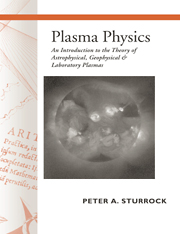Book contents
- Frontmatter
- Contents
- Preface
- 1 Introduction
- 2 Basic concepts
- 3 Orbit theory – uniform fields
- 4 Adiabatic invariants
- 5 Orbit theory
- 6 Electromagnetic waves in a cold electron plasma
- 7 Electromagnetic waves in an electron-ion plasma
- 8 Two-stream instability
- 9 Electrostatic oscillations in a plasma of nonzero temperature
- 10 Collision theory
- 11 MHD equations
- 12 Magnetohydrodynamics
- 13 Force-free magnetic-field configurations
- 14 Waves in MHD systems
- 15 Magnetohydrodynamic stability
- 16 Variation principle for MHD systems
- 17 Resistive instabilities
- 18 Stochastic processes
- 19 Interaction of particles and waves
- Appendix A Units and constants
- Appendix B Group velocity
- Appendix C Amplifying and evanescent waves, convective and absolute instability
- References
- Author index
- Subject index
19 - Interaction of particles and waves
Published online by Cambridge University Press: 05 June 2012
- Frontmatter
- Contents
- Preface
- 1 Introduction
- 2 Basic concepts
- 3 Orbit theory – uniform fields
- 4 Adiabatic invariants
- 5 Orbit theory
- 6 Electromagnetic waves in a cold electron plasma
- 7 Electromagnetic waves in an electron-ion plasma
- 8 Two-stream instability
- 9 Electrostatic oscillations in a plasma of nonzero temperature
- 10 Collision theory
- 11 MHD equations
- 12 Magnetohydrodynamics
- 13 Force-free magnetic-field configurations
- 14 Waves in MHD systems
- 15 Magnetohydrodynamic stability
- 16 Variation principle for MHD systems
- 17 Resistive instabilities
- 18 Stochastic processes
- 19 Interaction of particles and waves
- Appendix A Units and constants
- Appendix B Group velocity
- Appendix C Amplifying and evanescent waves, convective and absolute instability
- References
- Author index
- Subject index
Summary
We saw in the previous chapter that the equation governing the evolution of the particle distribution function has the form of a diffusion equation (18.2.19). When starting from the Fokker–Planck equation, it is not obvious why this should be the case.
In this chapter, we consider a homogeneous plasma and assume that the fluctuating electric and magnetic fields can be expressed as a distribution of normal modes of the plasma. We shall find that this approach leads directly to a diffusion equation. In addition, we shall find that the diffusion coefficient is related to the emission and absorption processes for the waves that comprise the normal modes.
Our analysis follows the semi-classical or quasi-quantum-mechanical approach due originally to Ginzburg (1939) and subsequently applied to plasma physics by Smerd and Westfold (1949), Pines and Schrieffer (1962), Melrose (1968) and Harris (1969). Our analysis will be restricted to the case that the unperturbed system contains no magnetic field. For a recent and more complete exposition of this procedure (that includes a possible magnetic field) see Melrose (1980).
Quantum-mechanical description
The relationship between emissivity, absorption and particle diffusion rests upon certain quantum-mechanical relationships. We therefore begin by describing the system in quantum-mechanical terms, taking note of the required relationships, and then making the transition to a classical description.
It is sufficient to consider a simple quantum-mechanical system with discrete energy levels (assumed non-degenerate) of energy E1, E2, …, with particle populations n1, n2,. … (See Fig. 19.1.)
- Type
- Chapter
- Information
- Plasma PhysicsAn Introduction to the Theory of Astrophysical, Geophysical and Laboratory Plasmas, pp. 301 - 310Publisher: Cambridge University PressPrint publication year: 1994

